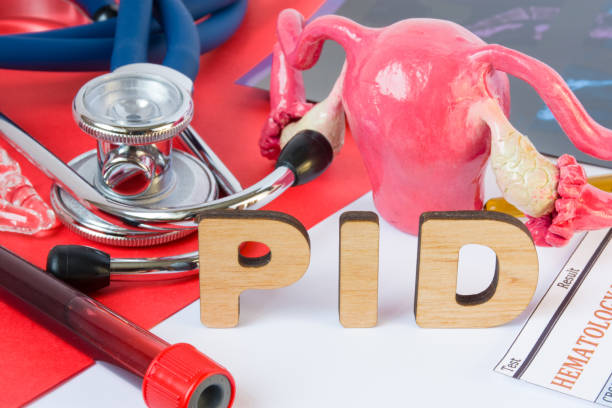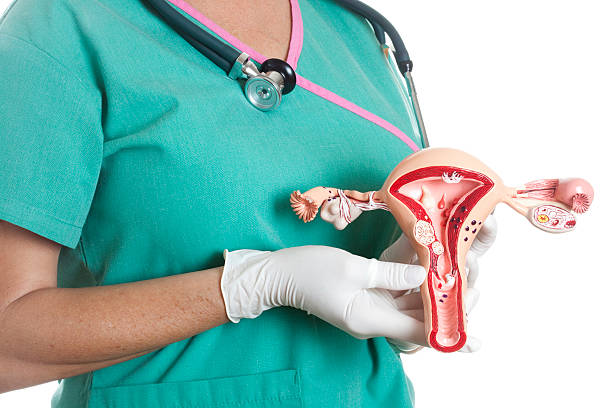Pelvic inflammatory disease (PID)
What is pelvic inflammatory disease?
PID is an inflammation of the pelvic organs, caused by an infection spreading from the vagina and cervix to the uterus, fallopian tubes, ovaries and pelvic area. Can cause an abscess inside the pelvis if severe causing tub ovarian abscess.
Etiology of pelvic inflammatory disease 
1. Neisseria gonorrhoeae and Chlamydia trachomatis identified as causative agents.
2. Gardnerella vaginalis, anaerobes and other organisms commonly found in the vagina may also be implicated.
3. Mycoplasma genitalium has also been associated with upper
Genital tract infection in women.
Clinical Features of pelvic inflammatory disease
Symptoms of pelvic inflammatory disease
1 • lower abdominal pain which is typically bilateral
2• deep dyspareunia
3• abnormal vaginal bleeding.
4• abnormal vaginal or cervical discharge which is often purulent
Signs of pelvic inflammatory disease
1• lower abdominal tenderness which is usually bilateral
2• adnexal tenderness on bimanual vaginal examination
3• cervical motion tenderness on bimanual vaginal examination
4• fever (>38°C)
Complications of pelvic inflammatory disease
1• Women with HIV complaining from severe symptoms associated with PID.
2• The Fitz-Hugh-Curtis syndrome comprises right upper quadrant pain associated with perihepatitis
Which occurs in some women with PID.
3• Removal of the IUD should be considered and may be associated with better short-term clinical outcomes.
Diagnosis of pelvic inflammatory disease 
• PID may be symptomatic or asymptomatic. But, clinical symptoms and signs lack
Sensitivity and specificity.
• Testing for gonorrhea and chlamydia in the lower genital tract.
• An elevated ESR or C reactive protein.
The differential diagnosis of lower abdominal pain in a young woman includes:
1• ectopic pregnancy.
2• acute appendicitis – nausea and vomiting occurs in most patients.
3• endometriosis.
4• complications of an ovarian cyst e.g. torsion or rupture.
5• urinary tract infection –associated with dysuria and urinary frequency.
Management of pelvic inflammatory disease
Delaying treatment of PID increase the risk of long term complication such as ectopic pregnancy,
Infertility and pelvic pain .
A low threshold for empiric treatment of PID is recommended so broad spectrum antibiotic therapy is required to coverN. gonorrhoeaeC. trachomatis.
Treatment of pelvic inflammatory disease
The following antibiotic regimens are evidence based
Outpatient Regimens
Metronidazole 400 mg twice daily for 14 days
- i.m. ceftriaxone* 500 mg single dose then oral doxycycline 100mg twice daily +
- Oral Levofloxacin 750mg once daily + oral metronidazole 400mg twice daily for 14 days
Alternative Regimens
- intramuscular ceftriaxone 500 mg immediately, then by azithromycin 1 g/week for 2 weeks
- oral moxifloxacin 400mg once daily for 14 days
Inpatient Regimens
- i.v. ceftriaxone 2g daily plus i.v. doxycycline 100mg twice daily then by oral doxycycline 100mg twice daily + oral metronidazole 400mg twice daily for a total of 14 days
- i.v. clindamycin 900mg 3 times daily + i.v. gentamicin
Followed by either oral clindamycin 450mg 4 times daily or oral doxycycline 100mg twice daily + oral metronidazole 400mg twice daily to complete 14 days.
Alternative Regimens
- i.v. ofloxacin 400mg BD plus i.v. metronidazole 500mg TID for 14 days
- i.v. ciprofloxacin 200mg BD plus i.v. (or oral) doxycycline 100mg BD plus i.v. metronidazole
500mg TID for 14 days
Pregnancy and Breastfeeding
• PID in pregnancy lead to increase in both maternal and fetal morbidity,
so parenteral therapy is advised
Surgical Management of pelvic inflammatory disease
• Laparoscopy, adhesiolysis and draining pelvic abscesses and maybe by ultrasound guided aspiration of pelvic fluid collections which less invasive and same effectiveness.
Sexual Partners
• Male partners of women with PID should be traced and screened
For gonorrhea and Chlamydia
• Gonorrhea or chlamydia diagnosed in the male partner should be treated appropriately and
At the same time with the index patient.
• Because many cases of PID are not associated with gonorrhea or chlamydia,
Empirical therapy should also be offered to male partners like Azithromycin 1g single
Dose.
• If screening for gonorrhea is not available additional specific antibiotics effective against
Neisseria gonorrhea should be offered like Ceftriaxone 500mg single dose intramuscularly.
• Partners should be advised to avoid intercourse until treatment course is completed.
Follow Up of cases of pelvic inflammatory disease
After 72 hours follow up is recommended, and should show an improvement in clinical symptoms and signs.
Failure to improve suggests the need for further investigation, parenteral therapy and/or surgical
Intervention.
Further review 2-4 weeks to ensure:
1• adequate clinical response to treatment
2• compliance with oral antibiotics
3• screening and treatment of sexual contacts
4• awareness of the significance of PID and its complication
5• repeat pregnancy test.
Repeat testing for gonorrhea or chlamydia after 2 to 4 weeks is appropriate in those
Persisting symptoms, antibiotic resistance pattern, compliance with antibiotics.
Dr Najeeb Layyous F.R.C.O.G
Consultant Obstetrician, Gynecologist and Infertility Specialist







 Pregnancy Due Date Calculator
Pregnancy Due Date Calculator
 Chinese Gender Predictor
Chinese Gender Predictor
 Ovulation Calculator
Ovulation Calculator
 IVF Due Date Calculator
IVF Due Date Calculator
